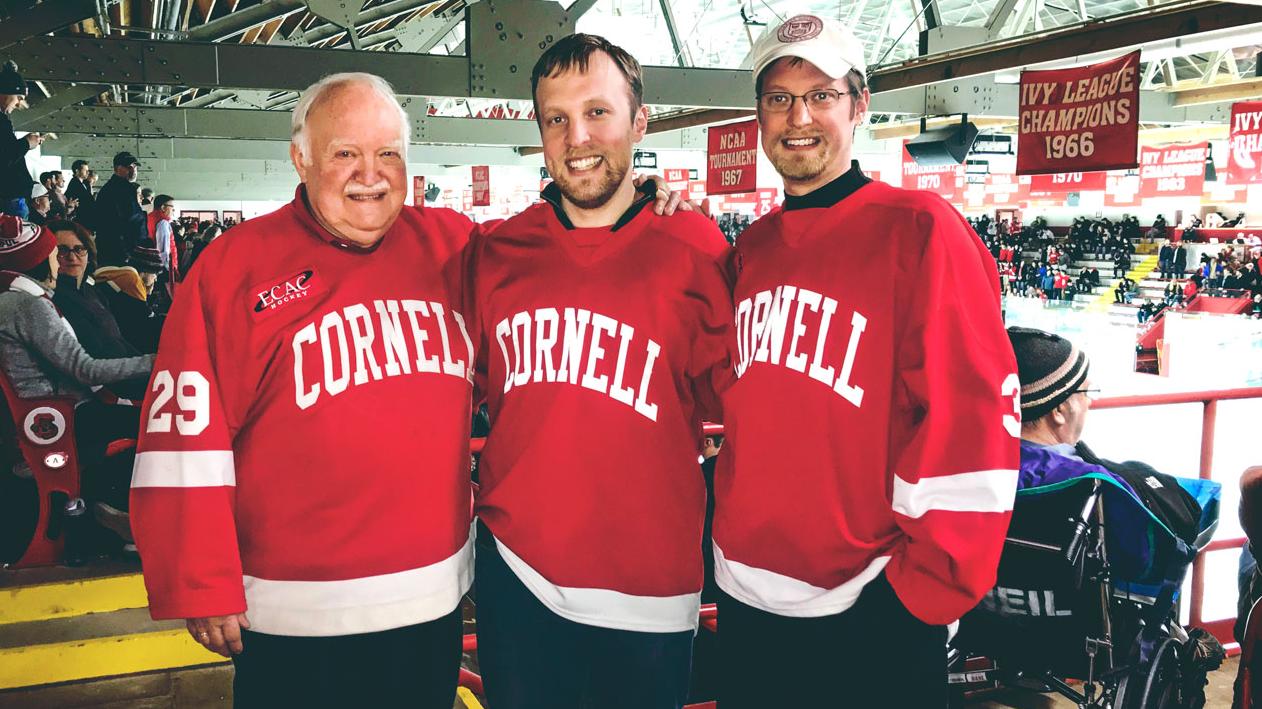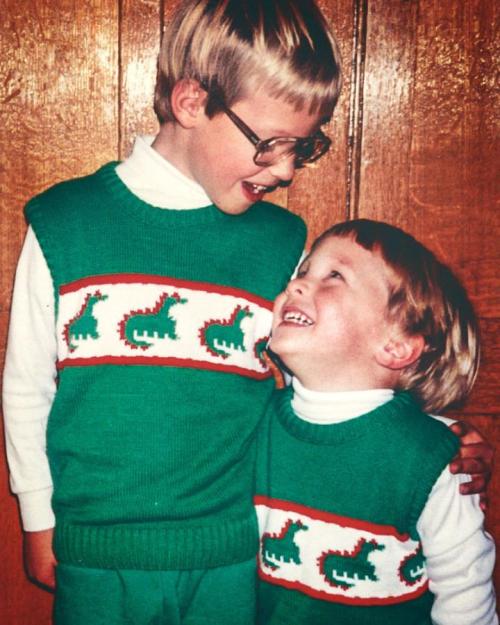As the Earle brothers like to put it, Evan “does the stuff” and Corey “does the story.”
Evan Earle ’02, MS ’14, is the University Archivist—responsible for collecting and preserving materials pertaining to Cornell’s history, and making them accessible to researchers and the public.
His younger brother, Corey Earle ’07, is the University’s longtime (if unofficial) historian: as a visiting lecturer in American studies, he teaches AMST 2001: The First American University—affectionately known as “Storytime with Corey”—a wildly popular one-credit course on Cornell lore.
Corey also frequently speaks to alumni groups and serves as a resource to innumerable administrators and departments—in addition to his full-time job as a principal gifts officer in Alumni Affairs and Development.
Members of a large, multigenerational Cornellian clan, Evan and Corey grew up in the Ithaca area as faculty kids; their dad, Brian Earle ’67, BS ’68, MPS ’71, taught communication in CALS for nearly four decades before retiring in 2008.
(Their great-uncle, Paul Hoff, MS ’40, was the first to attend, followed by their grandfather, CALS professor Wendell Earle, PhD ’50, and all five of his children.)
From early childhood, the Earle brothers were surrounded by history: their family home, a former parsonage in West Dryden, dates from 1832.
This summer, the brothers are teaming up to teach their first joint course, titled “Cornell, Collections & Conflict.” Offered through Cornell’s Adult University and based in Kroch Library, the weeklong class will examine the institution’s history through the lens of its archival holdings, with a focus on notable eras from the Civil War to the COVID-19 pandemic.
In early May, Cornellians got Evan and Corey together for a chat in Kroch—the subterranean space that’s home to the University Archives—to reflect on their roles as “brothers in Big Red history.”
What are your earliest Cornell memories?
Corey: I remember going to my dad’s office in the old Roberts Hall before it was torn down, playing on a chalkboard as he was getting ready to move out.
Evan: He would bring us to his classes—it wasn’t frequent, but enough that it stands out as a memory, seeing him lecture and interact with students. But my strongest affiliation with campus in my youth was hockey games. My parents brought me as an infant and I had season tickets from my grandparents when I was 10. I thought all Cornell students were hockey fans.
Corey: Hockey players were my babysitters, because several would live with our grandparents each year, before the NCAA cut down on that practice.
Evan: We had all these “older brothers” who were players. I’d bring them to school for show-and-tell; they’d bring all their equipment, sign autographs, and talk about being on the team. One way that I built ties to Cornell was through these hockey players being so loving with us as little kids.
Do you have a favorite piece of Cornelliana, either something in the Archives or that you own?
Corey: I have the Andy Bernard diploma that hung on the wall in “The Office.” They auctioned off the props after the show ended, and Evan purchased it for me as a birthday present—and when Ed Helms gave the Convocation address, I had him sign it. When I give the lecture in my class on “Cornell and pop culture,” I bring it in and students pose with it.
Evan: Having the charter that established the University in the Archives is amazing. We also have the seminal letters of Ezra Cornell—the one where “any person, any study” is first used; and the one about an African-American student, saying “send him”; and the one to his granddaughter about wanting women to be educated here. I also like that we have the very first diploma that the University ever gave—from the first class, and the first person alphabetically.
Corey: I wonder if any other universities have their first diploma? I imagine that’s rare.
Evan: Yes, it’s very special. But actually, the thing I usually say is my favorite item is the socks that Ezra Cornell wore on his wedding day. His mother saved them, and they went up on the Space Shuttle Columbia [carried by astronaut G. David Low ’80].
What do you admire most about your alma mater?
Evan: The breadth—of the fields of study, the faculty, the students. Other than all being here and connected to the University, we’re not homogenous. This is a place where you can have a conversation with someone who has a completely different background from you, and do so comfortably. And to some degree, I think that extends to the Ithaca community as a whole.
If you could time travel to the 1800s and ask Ezra one question, what would it be?
Evan: I’d pick his brain further, to hear in his own words: what did “any person, any study” mean to him? We have his writings about it, and I think we can say that he truly believed in that message. But to hear him explain what he meant by that vision—I’d love to learn that from him.
Corey: In the context of higher education today, it’d be interesting to see how the interpretation of “any person” has evolved over the years; how similar is it today to what he meant? I don’t think many people realize how progressive this farmer in the 1860s was. He was thinking about things that people weren’t having conversations about until decades later—the whole idea of access and inclusion in higher education. Back then it was mainly for wealthy, white, Protestant men. Ezra Cornell was really ahead of his time.
On a similar note: if you could have coffee with any Cornellian from history, whom would you choose?
Corey: [Founding president] Andrew Dickson White was around for so long—he saw a third of Cornell’s history—so he would have a great perspective. But I don’t think he was a lot of fun to hang out with; he was a very serious guy. On the other hand, he was an ambassador and entertained people from all over, so he was probably pretty good at sitting down for coffee or tea and telling stories.
Evan: He was here from the beginning. Hearing what he thought of the University toward the end of his life, in the middle of World War I—Was it going the right direction? What would he like to see it accomplish in the future?—would be fascinating.
Evan, as the University Archivist, what do you think of Corey’s class on Cornell history?
Evan: Well, to have an opinion, I needed to see it firsthand—so when I was a grad student, I took it for credit. And I really enjoyed it. But what also makes me happy about his course is the number of people he’s impacting—not only getting them to understand important aspects of Cornell history that make us such a unique institution, but building community and the togetherness of the shared experience of what it means to be a Cornell student.
Finally, how do you think Ezra would feel about the institution he founded, if he could see it today?
Corey: He was into the cutting edge of things; the telegraph, this great new invention—he wanted to explore it and invest in it. He believed in technology improving our lives and the future. So I think he’d be excited to see how that is continuing to play out.
Evan: I think he’d be pleased at how much innovation is taking place here—not necessarily focused on engineering or technology, but being at the forefront of your field, regardless of subject.
Corey: And he’d be astonished at the growth of the University, and its diversity. He kept a little diary of where students came from; he was really proud of the fact that Cornell drew students from all over the world. So looking at the student body today—I think that would be fun for him.
Read the story in Cornellians.






